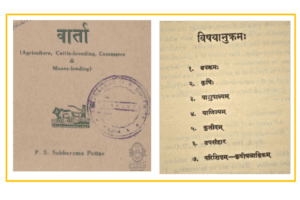Varta In Ancient Bharat – An Overview
It is rather disturbing that “Varta”, which was an important subject of ancient Bharat that provided vast knowledge has now completely vanished. In contemporary times, there is hardly any Hindu who is aware of the subject of Varta in the Bharatiya Gurukula education. This article attempts to provide an overview of Varta – a part of the rich cultural heritage of Sanatana Bharat.
The origin of Varta
“Varta” was taken from the word “Vrtti” which stands for both “livelihood” and the knowledge an individual requires to earn their livelihood.
- Varta is related to economics more specifically it teaches how to do economic value addition through agriculture, trade, money lending, and animal breeding. Later sculpting and many hastakalas (skilled crafts) also became part of Varta.
- Even aspects specific to the national economy were encompassed under the purview of Varta.
- In Sanatana Bharat, it was required for rulers to be fully knowledgeable about Varta for the sake of its impact on the national economy. It was only then that a king was able to maintain economic stability in their empire.

Varta – more details
At this juncture, it will only be worthwhile to elaborate on some more key details for a better understanding of “Varta.”
- In that era of Bharat, Varta was considered “the roof of the world”, like the importance that a roof plays to the inhabitants of the house by protecting them. This analogy highlights the significance that was attached to this subject of Varta.
- We find a reference to the subject of Varta in numerous scriptures and ancient texts of Bharat. The Ramayana, the Mahabharata, the Bhagavata Purana, and Artha Shastra are just a few examples, in this connection.
- Varta has predominantly a non-Brahmanical character to the subject. While Brahmins were strictly prohibited from making money from their knowledge. The knowledge of Varta was intended to create positive economic outcomes by its application in an occupation by the Vysya community.
- It can be said that the tenets of “Varta” were chiefly applicable to “Vysyas.” In the Bharatiya society of pre-modern era, Vysyas were the people involved in the economic value addition activities of trade, money lending, agriculture, animal husbandry, as well as skilled craftsmen.
- One key observation is that today, we do not consider agriculture, animal husbandry, and skilled crafts as roles of Vysya varna. This could be the effect of changes brought by British rule – destroying the traditional education system, promoting British manufactured goods in India, and reduction in spending on micro irrigation. The British colonialists were only interested in looting the Indian sub-continent by taking out all its wealth and sending it to Britain. As a result, only the traders and industrialists could prosper and not those in farming, animal husbandry, and traditional skilled craftsmen.
Varta and the Purusharthas
As per the Bharatiya philosophy, the four Purusharthas are among the most significant principles of human existence. The Purusharthas are: Dharma, Artha, Kama, and Moksha.
As you may already know, in the Purushartas – dharma or good conduct comes ahead of Artha, Kama, and Moksha. So it is clearly implied that the knowledge of Varta must be used without violating dharma which is a very broad concept covering human ethics, good behavior, morals, and consideration for other human beings.
Artha is inclusive of things such as earning wealth, business/profession, career, financial stability, and livelihood at the individual or family level. Artha includes the national economy and several other items like keeping wealth in the government treasury for use in droughts, famines, and floods
Because of the points discussed above, it is clear that Varta comes under Artha. All these elements have materialistic growth as their primary driving force. It’s obvious that knowledge of “Varta” was essential to do well in the area of “Artha.”
Importance of Varta vidya – time to educate and revive
It’s high time that Bharat understands the importance of “Varta”, and revives this subject as a prominent subject of knowledge. It is quite obvious that the immense material wealth in Sanatana Bharat was mainly due to a large section of the population was involved with applying the principles from the “Varta” vidya in society.
Due to a large section of the population being well-versed in various aspects of Varta, Sanatana Bharat was the source for providing many material comforts and services not just to those living in Bharat but also to those living in faraway countries in Africa, Eastern Asia, and Europe. No wonder, Bharat’s share of the world economy(as a percentage of GDP) was nearly 40%. This was before British colonialists destroyed Bharat with their loot-centered approach to administering Bharat (that is India).
